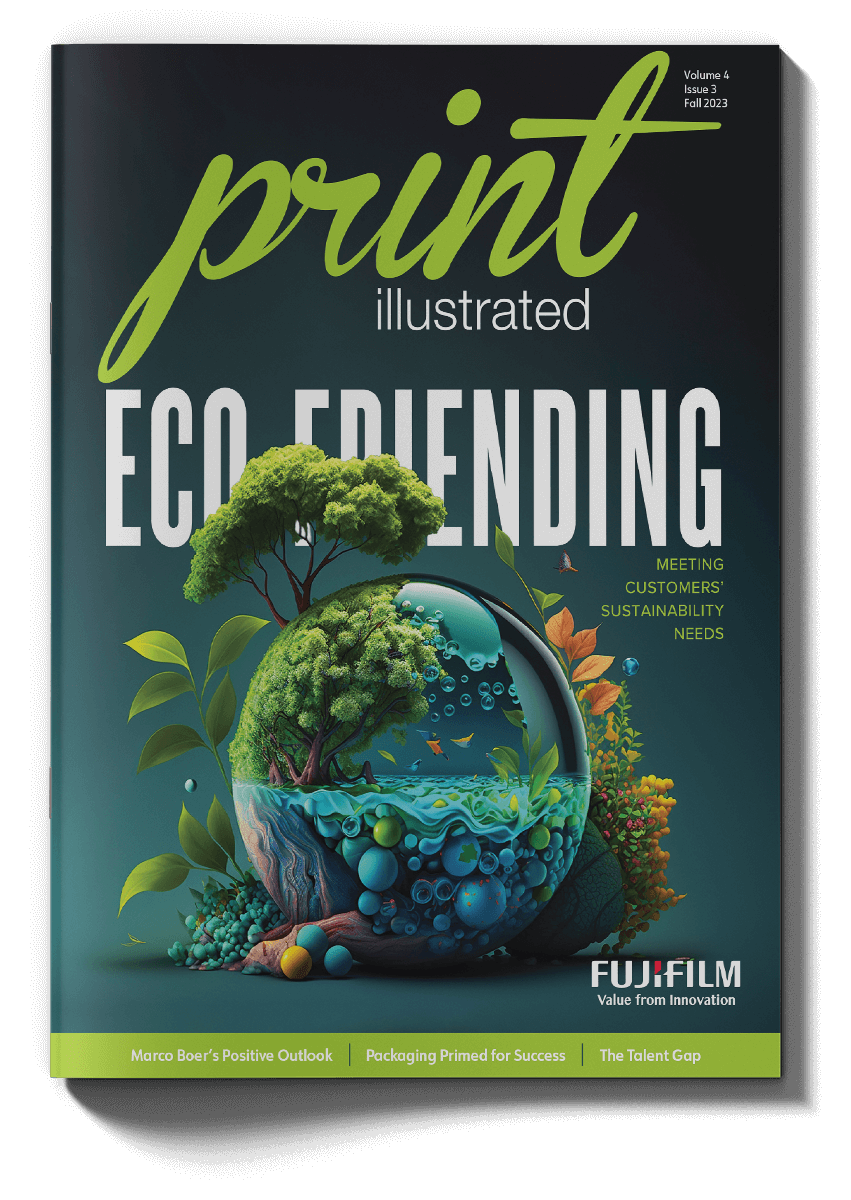Recyclable. Compostable. Biodegradable. When GOpak talks about sustainability, the conversations go far deeper than putting catchphrases in a marketing slogan. To be fully immersed in the space—to be the kind of brand that stands out to consumers—GOpak offers a variety of material options that define its sustainability commitment.
For example, its EBeam technology eliminates the need for a secondary lamination layer, which, in turn, reduces raw material use and allows for recyclable, compostable and biodegradable materials to be utilized. By choosing flexible packaging, GOpak is putting itself and its consumers one step ahead of the game.
AJ Buran, President of Sales at the flexible packaging option provider, says it started with two pillars in mind: speed to market and sustainability. In tandem, the digital press and its EBeam technology hit the bullseye of both speed to market and improved sustainability. That way, its customers can eliminate a layer of material by using the EBeam technology to protect the inks rather than reverse printing and laminating. Most of the flexpack industry reverse prints on PET, then glues the film to the rest of the structure, which adds a couple of days of set-aside time for the adhesive to bond properly.
“When it comes to print on paper, the right things are often buried under an avalanche of misinformation driven by corporate greenwashing, pop culture media, competitive interests and anti-paper environmental activists.”
– Kathi Rowzie, President, Two Sides North America
In a time when all eyes are on a brand’s sustainability efforts, GOpak continues to expand its offerings. “There tends to be a lot of talk around sustainability, but the action taken has been slow. There is so much confusion, politics and greenwashing in the marketplace. But brands are getting more educated to make good choices for their businesses. Ultimately, sustainability needs to make financial sense for the brands to operate.”
For companies like GOpak and others in the flexible packaging space, one of the biggest challenges is the limited ability to recycle and reuse the plastic. This is due to different types of plastics that are laminated together. Chemical recycling, which some have as about 10 years out, is being developed and scaling to be able to separate the layers to be reused.
Today, the GOpak team continues to expand its sustainable offerings. Take electron beam curing, which is designed to help protect the inks and graphics without adding a layer. This makes it easier for compostable materials to compost and recyclable materials to be recycled. It also has been using landfill biodegradable materials called PakZero. Because it is biodegradable, it breaks down in an anaerobic landfill environment.
Buran says that digital printing has been another player in helping to reduce waste. In addition, RFID/NFC-smart packaging and QR codes help give consumers access to updated information, as well as assist brands in tracking and tracing.

The answers are out there
From where she sits, Kathi Rowzie has a unique view on the commercial print industry’s sustainability story. As President of Two Sides North America, she helps steer the group’s straightforward, balanced approach to the greening of print, paper and paper-based packaging.
As part of the non-profit Two Sides global network, Two Sides’ reach can be pretty wide. The global network includes more than 600 member companies across North America, South America, Europe, Australia and South Africa. Its member companies span the graphic communications and paper-based packaging value chain, touching the areas of forestry, pulp, paper, paper-based packaging, chemicals and inks, pre-press, press, finishing, printing, publishing, envelopes and postal operations.
Rowzie says print customers and their customers are increasingly aware of the environmental impacts of the products they buy and use. That means everyone understandably wants to do the right things—even if doing so becomes a battle between fact and disinformation.
“When it comes to print on paper, the right things are often buried under an avalanche of misinformation driven by corporate greenwashing, pop culture media, competitive interests and anti-paper environmental activists. It’s a business imperative that printers arm themselves with the facts to help their customers and other stakeholders understand the inherent environmental benefits of print on paper, and how it contributes to a more sustainable, circular economy.”
From Two Sides’ perspective, it helps to tackle relevant environmental and social issues head-on with an arsenal of factual, authoritative information that works to quash myths and explain the industry’s sustainability goals. The resources help give stakeholders a solid foundation for making well-informed decisions about the use of print and paper products.
“There tends to be a lot of talk around sustainability, but the action taken has been slow. There is so much confusion, politics and greenwashing in the marketplace.”
– AJ Buran, President of Sales, GOpak
As Rowzie says, the truth—and untruths—are out there. For example, paper is one of the few products on earth that already has an environmentally sustainable, circular life cycle. North American paper is made from an infinitely renewable natural resource—trees, which are purpose-grown, harvested and regrown in sustainably managed forests.
“Paper is manufactured using mostly renewable, carbon neutral bioenergy in a process that uses a lot of water,” Rowzie says. “But in reality, it consumes very little of it. And with a 68% recovery rate, paper products are recycled more than any other material in the country’s municipal solid waste stream.”
Buran believes that the solutions and answers to the industry’s sustainability path are ones that more companies should be willing to embrace and share. For example, it is helpful to undertake actions like using eco-friendly materials when possible. Waste reduction. Press optimization. Training employees. Continuous improvements in production, shipping and receiving. Choose suppliers with the same intentions. And the list goes on.
“It all comes down to transparency,” Buran says. “We, as an industry, must be able to show and share our progress without avoiding industry challenges.”
That is one of the approaches Two Sides—and others—hope catches on. The bottom line is that with consistent, verifiable messaging that is able to continually demonstrate the industry’s wealth of sustainable benefits, the industry—everyone on every side—can make a difference that can be measured.
Myths and facts you should know
Myth: The production and use of paper is destroying U.S. forests.
Fact: U.S. forests are a renewable natural resource that is continuously replenished through sustainable forest management and natural regeneration.
The Skinny: U.S. forestland totals around 766 million acres, with the total live-tree volume exceeding 1 trillion cubic feet. This translates to nearly 9 billion stacked cords of wood. Each year, U.S forests grow approximately two times more tree volume than is harvested, with a net average annual increase in growing stock of about 25 billion cubic feet.
Myth: Paper manufacturing is a major cause of greenhouse gas emissions that contribute to climate change.
Fact: The pulp and paper industry contributes less than 1% of total U.S. greenhouse gas emissions.
The Skinny: Carbon neutrality is an inherent property of biomass reflecting the fact that the carbon residing inside it was only recently removed from the atmosphere, so returning it to the atmosphere has no net effect on atmospheric CO2. This inherent property exists whether or not trees are regrown.
Myth: Paper manufacturing uses excessive amounts of water.
Fact: While paper-making requires large amounts of water, very little water is actually consumed in the production process.
The Skinny: In a typical U.S. paper mill, process water is recycled 10 times or more, then is cleaned to meet strict U.S. water quality standards. Approximately 90% is returned to its source. About 1% remains in the manufactured products, with the rest evaporating back into the environment.
Myth: Using paper products is wasteful.
Fact: Paper recycling extends the supply of a valuable natural resource (wood fiber from sustainably managed forests), saves landfill space, and avoids greenhouse gas emissions (methane) that result when paper decomposes in landfills.
The Skinny: In 2022, 68% of paper and paper-based packaging in the U.S. was recovered for recycling. The recycling rate for cardboard, what the industry calls corrugated, was 93.6%. About 80% of U.S. mills use recycled fiber.
Myth: Only recycled paper should be used to make new paper products.
Fact: The continuous input of wood fiber from sustainably managed forests is essential to the paper production cycle.
The Skinny: Every time paper is recycled, the fibers get shorter and weaker. After being recycled 5 to 7 times, the fibers become too short and weak to bond into new paper. Mills producing fresh fiber use different processes than mills using recycled fiber. As a result, the releases to the environment differ.
Myth: Paper is a dying industry.
Fact: The U.S. paper industry makes products essential for everyday life.
The Skinny: The U.S. forest products industry is among the top 10 manufacturing employers in 43 states. The industry directly employs approximately 925,000 people and supports more than 2 million additional jobs throughout the supply chain. The forest products industry also is a major contributor to the U.S. economy, representing approximately 5% of manufacturing GDP.
Source: “Paper & Paper-Based Packaging Busting The Environmental Myths” — Two Sides North America

